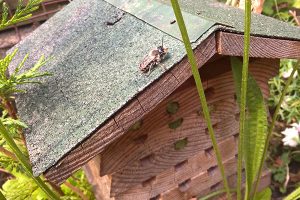The Joy of Leaf-Cutter Bees

Bee and Insect Hotels
Having a bee or insect 'hotel' in your garden is increasingly popular at the moment. As people are becoming more aware of the importance of bees, as well as the threats they face due to modern pesticides, predators and loss of habitat, the general public is welcoming the idea of doing what they can to help these valuable creatures and protect them from decline.
Bees are fascinating and beautiful insects. Most people are familiar with honey bees, which are well known for producing honey, but there are many other types of bee, in fact there are approximately 20,000 species of bee in the world and more than 250 species of bee are found in the UK.
Bees are important pollinators of plants, and experts have estimated that one third of the food we eat is dependent on insect pollination! Bees are found on every major continent except Antarctica. Wherever there are flowering plants that are pollinated by insects, there are bees.
Bees found in the United Kingdom
Aside from honey bees and bumble bees, some more common types of bee found in the UK are: leafcutter bees, mason bees, carpenter bees, digger bees and mining bees.
While honey bees and bumble bees live in colonies, many other species of bee are known as 'solitary bees' who prefer to nest on their own. Solitary bees and their nesting habits are diverse, with some bees excavating a nest in the ground, while others nest in small holes found naturally in brick walls or dead wood. There is even a small group of bees that nest in empty snail shells!
Leaf-cutter bees
Leaf-cutter bees belong to the Megachilidae family and are so named because of their method of cutting pieces of leaves with which to construct their nests. They usually favour smooth leaves that are not too thick such as leaves from roses or azaleas.
Solitary bees such as leaf-cutters really are busy little bees and can do the work of up to 20 honey bees! Honey bees may be more famous but leaf-cutter bees are actually more effective pollinators. Because leaf-cutters carry pollen on their dry underbelly (honey bees wet the pollen and carry it on their legs) the pollen falls off easily as they travel flower to flower and they pollinate more flowers than honeybees as a result. Leaf-cutter bees pollinate wildflowers as well as many fruits and vegetables including carrots, onions and blueberries.
Solitary and hard working
Every female leaf-cutter bee is a solitary queen, which means that she has to do everything herself; searching for a nest, inspecting it to ensure it's suitable, leaf gathering, gathering of pollen and nectar, laying her eggs, gathering leaves again, then sealing the cavity to ensure it's protected from predators. Because she does everything herself, she cannot spend much time guarding her eggs. Leaf-cutter bees are non-aggressive, don't swarm, and are generally safe around people and pets unless handled and provoked.
Nesting
Leaf cutters like to make multiple cells in a nest and tend to use existing cavities, usually in dead wood, brick walls or plant stems. They prefer to forage within about 100m of their nest. They do seem to like company though and will often build nests close to one another (but will not share nests). When a nest has been established it is respected by other leaf-cutters.
Once the leaf-cutter has selected, inspected and cleaned an appropriate nesting area she will begin the process of preparing and stocking the nest. For gathering leaves, she will select a plant with suitably soft and smooth leaves (rose or wisteria leaves are favourites) and then using her mandibles (jaws) she'll cut a semi-circle of leaf and fly with it back to the cavity she's chosen as a nest. She will carry it close to her body - tucked under her legs and abdomen. Each leaf may weigh ¼ of her own weight! She'll use the pieces of leaf to line the outer walls of the cavity, gluing them together with saliva and creating a hollow, cigar shape. She'll then stock the cell with nectar and pollen, lay an egg on the food she's provided and finally seal the cell shut with more leaves.
This procedure will then be repeated with the next cell. If she has enough cavities, she may lay between 30 and 50 eggs, so the whole process can take several weeks to complete, especially if the weather is bad. On a rainy or windy day, you may be lucky enough to spy a leaf-cutter bee sitting inside a cell, near the entrance, waiting for the weather to change. A female leafcutter bee only lives for a few weeks and is therefore kept very busy during her short life, and time is precious. As for the larvae; they will hatch, eat the pollen provided and, as they grow larger, they will spin a silk cocoon from which they'll emerge after about 30-50 days.
Making a home for solitary bees
Although solitary bees will make use of any cavities found in the ground, trees, old brickwork, old wood etc, you can help them out by either making or buying a suitable nest for them. There are many bee and bug 'hotels' that you can buy.
Catherine, one of our Find Me A Gift family, had a Solitary Bee Hive in her garden for 3 years without it attracting much activity. Then she noticed that her bee hotel had suddenly been filled with leaves, indicating that it had become a leaf-cutter bee nest!
Another of our FMAG family, Adrian has a bee home in his garden too. Many thanks to both of them for being kind enough to supply us with some great photos.
Creating a home for bees can be very rewarding but remember you may need to bee patient!











